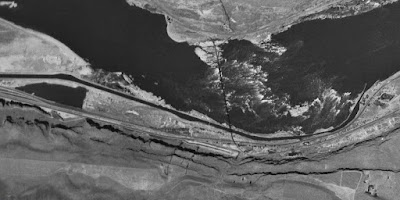Signal Hill, east of The Dalles
Heading up Fifteenmile Creek southeast of The Dalles, I noted a gravel quarry high up on the divide between Fifteenmile Creek and the Columbia River on the east side of Signal Hill. The gravel unit is part of the Dalles Formation that covers much of the western high plains of northern Oregon south of the Columbia River Gorge. The Dalles Formation is a volcanic sedimentary unit derived from an older stage of Cascade volcanoes with some sediment derived from the east.
Further up Fifteenmile Creek is another gravel quarry.
This gravel unit is from the ice age floods that flowed down through the Columbia River Gorge. The flood was deep enough that it over topped the Columbia River Gorge and spilled into Fifteenmile Creek.
The Columbia River Gorge formed a restriction that caused flood waters to back up forming temporarily Lake Umatilla to the east of the gorge. Using a 340 meter elevation for the high water from the ice age flood in the area (Benito and O'Conner, 2003) on a DEM shows the extent of the backed up water.
DEM of large ice age flood
Focusing on the dividing ridge between Fifteenmile Creek and the Columbia River shows water crossed the divide at two locations.
Ice-age flood spillover from Columbia Gorge into Fifteenmile Creek.
The western spillover covered the entire western end of the dividing ridge including Signal Hill. The eastern divide spillover deposited the gravel in the above image.
The two spillovers can be seen from the Washington side the gorge looking south across the gorge to the Oregon side.
Signal Hill just below and to the right of Mount Hood is the location of the western spillover
The eastern spillover formed a valley across the divide.
The bedrock cliffs are Columbia River Basalt Group
Benito, G., and O’Connor, J. E., 2003, Number and size of last-glacial Missoula Floods in the Columbia River
valley between the Pasco Basin, Washington, and Portland, Oregon: GSA Bulletin, v. 115, no. 5, p 624–
638. https://doi.org/10.1130/0016-7606(2003)115<0624:nasolm>2.0.CO;2







































